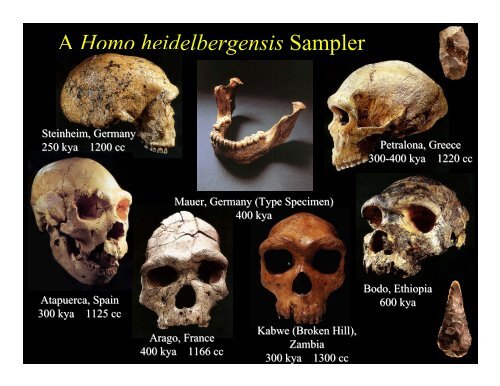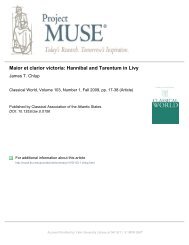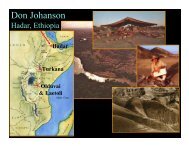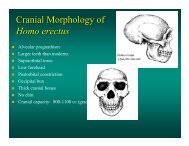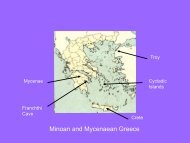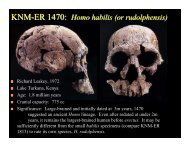Late Homo Famous Fossils
Late Homo Famous Fossils
Late Homo Famous Fossils
You also want an ePaper? Increase the reach of your titles
YUMPU automatically turns print PDFs into web optimized ePapers that Google loves.
A <strong>Homo</strong> heidelbergensis Sampler<br />
Steinheim, , Germany<br />
250 kya<br />
1200 cc Petralona, , Greece<br />
300-400<br />
kya<br />
1220 cc<br />
Mauer, , Germany (Type Specimen)<br />
400 kya<br />
Atapuerca, , Spain<br />
300 kya<br />
1125 cc<br />
Arago, , France<br />
400 kya<br />
1166 cc<br />
Kabwe (Broken Hill),<br />
Zambia<br />
300 kya<br />
1300 cc<br />
Bodo, , Ethiopia<br />
600 kya
Neanderthal Origins: La Sima de los Heusos<br />
Atapuerca, Spain<br />
“The Pit of Bones”<br />
300 kya<br />
Dozens of individuals<br />
Classified as<br />
H. heidelbergensis<br />
Proto-Neanderthal<br />
features
Neanderthal<br />
<strong>Homo</strong> sapiens neanderthalensis<br />
Neander Valley,<br />
Germany 1856<br />
Age: 40-50,000<br />
Significance: First human<br />
fossil acknowledged<br />
as such, and first specimen of<br />
Neanderthal. Most dismissed<br />
it as a freak, but<br />
Doctor J. C.<br />
Fuhlrott<br />
speculated that<br />
it was an ancient<br />
human.
“Old Man” of La Chapelle<br />
H. sapiens neanderthalensis<br />
or H. neanderthalensis<br />
La Chapelle<br />
Aux-Saints,<br />
France<br />
Age: 50,000 years<br />
Cranial Capacity:<br />
1625 cc<br />
Early studies of this elderly<br />
male mistook symptoms<br />
of advanced age for signs<br />
of brutishness
Kebara 2: “Moshe”<br />
<strong>Homo</strong> sapiens neanderthalensis<br />
or <strong>Homo</strong> neanderthalensis<br />
Moshe’s<br />
fingertip<br />
Hyoid<br />
Modern<br />
Kebara Cave, Israel<br />
Lynne Shepartz, 1983<br />
Age: 60,000 years<br />
Neanderthal skeleton, lacking cranium and legs.<br />
Includes a modern-looking hyoid (throat) bone<br />
and distinctly broad, flat fingertip bones.
Omo-Kibbish 1<br />
<strong>Homo</strong> sapiens sapiens<br />
Kimoya Kimeu. 1967<br />
Omo Basin, Ethiopia<br />
Age: 130,000 years<br />
Perhaps the oldest known<br />
fossil of fully modern<br />
<strong>Homo</strong> sapiens sapiens
Border Cave,<br />
South Africa<br />
<strong>Homo</strong> sapiens sapiens<br />
70-130 kya
Klasies River Mouth<br />
South Africa<br />
<strong>Fossils</strong> and footprints<br />
117 kya<br />
<strong>Homo</strong> sapiens sapiens
Qafzeh IX <strong>Homo</strong> sapiens sapiens<br />
Qafzeh cave, Israel, 1969<br />
Qafzeh, Skhul, and others like them were once thought to follow the Middle Eastern<br />
Neanderthals in time. However, ESR and TL dating now put them at 90,000 to 100,000<br />
years–older than Middle Eastern Neanderthals.<br />
Qafzeh IX<br />
Adult female<br />
Skhul 5<br />
Adult male
Kow Swamp 1 <strong>Homo</strong> sapiens<br />
Alan Thorne, 1967<br />
Kow Swamp, Australia<br />
Age: 10,000 years<br />
These odd-looking<br />
skulls have a<br />
flattened forehead<br />
that Alan Thorne<br />
compares with Java<br />
erectus; Thorne uses<br />
them as supporting<br />
evidence for multiregional<br />
evolution of<br />
modern humans. Some<br />
suggest that Kow 5 may<br />
have been artificially<br />
deformed.<br />
Kow Swamp 1 Kow Swamp 5
Lagar Velho <strong>Homo</strong> sapiens?<br />
Lagar Velho, Portugal,<br />
1998<br />
24,500 years old (later<br />
than any true Neandertals)<br />
Trinkaus & Zilhao<br />
Modern-like jaw with<br />
Neandertal-like skeleton?<br />
Evidence of lingering<br />
Neanderthal traits, from<br />
interbreeding?<br />
Tattersall says no, only a<br />
“chunky modern”<br />
QuickTime and a<br />
Photo - JPEG decompressor<br />
are needed to see this picture.


